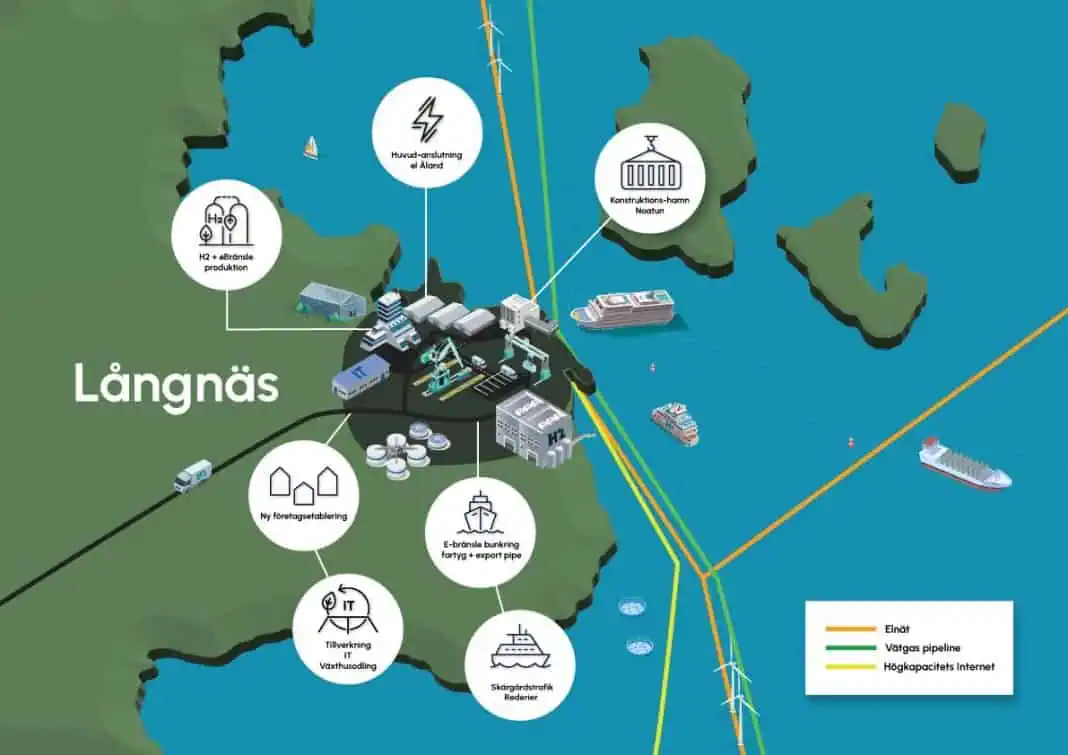OX2 and the Bank of Åland’s mutual fund subsidiary Ålandsbanken Fondbolag, which are developing the Noatun North and Noatun South offshore wind power projects near Finland’s Åland archipelago in the Baltic Sea, have initiated a feasibility study for the planning and establishment of a “Mega Grön Hamn” (Mega Green Port) with a location coexisting with the port of Långnäs in Åland. The project is a key element of efforts to create the Nordic region’s leading green hub in Åland, with an extra focus in this project on the shipping segment and the establishment of new business operations in Åland.
Långnäs is a suitable hub for OX2’s and the Bank of Åland’s joint offshore projects Noatun North and South − for construction, electrical connections, hydrogen and electrofuel (e-fuel) production/distribution as well as other newly established business operations. The project team consists of representatives from OX2, the Bank of Åland, the Mærsk Mc-Kinney Møller Center for Zero Carbon Shipping, EuroMekanik and a number of other consultancies.
Fully developed, the port will function as a green node and − in addition to construction logistics for the individual wind power projects − will open opportunities for the creation of new business operations, new jobs, an electrical connection to Åland and much more. The capacity requirement for Långnäs is estimated at 3,000 megawatts (MW), which is the maximum size of the electrolyser.
“Creating a Mega Green Port will bolster the Åland economy in many different ways. In addition to being an important part of the offshore wind power projects, it will generate jobs and produce e-fuel for the shipping industry − making Åland attractive for the establishment of large business operations and enabling many new innovative projects in oxygenation of waterways and utilisation of excess heat in various manufacturing activities. The port will strengthen Åland’s potential to become the leading green hub in the Nordic region,” says Anders Wiklund, Country Manager Åland at OX2.
The Mega Green Port project includes plans to produce hydrogen as a fuel for the shipping industry, for future local archipelago transport services and for industrial processes in Åland. Långnäs will also become an important hub for transporting hydrogen through the planned Baltic Sea Hydrogen Collector south to the European continent.
The project company is also conducting a dialogue directly with international companies about establishing new operations in Åland. This includes both the manufacturing sector, the information technology (IT) industry and potential agricultural opportunities, which are all dependent on large-scale green energy production.
“The purpose of our planned wind power projects is green energy transition and enabling the general public to participate via our mutual fund structure − but perhaps, above all, to create a new growth engine for the Åland business sector. The feasibility study for Långnäs as a Mega Green Port is an important step in understanding how Långnäs can play a key role in the future of the Åland business community, especially with reference to the growth of existing Åland companies and the establishment of new business operations,” says Peter Wiklöf, Manager Director and Chief Executive of the Bank of Åland.
The Mærsk Mc-Kinney Møller Center for Zero Carbon Shipping in Copenhagen, Denmark is an independent, world-leading research and development organisation specialising in green maritime fuels, with a strong connection to the world’s largest shipping company Maersk and corporate partnerships with NYK Line, Hapag-Lloyd as well as trading houses and technology suppliers. The Center’s close participation in the Mega Green Port project will provide important knowledge about green e-fuel and port development, which it works with on a global basis.
“We are very much looking forward to being involved in this feasibility study, the vision for Åland and the role that Långnäs can play for shipping. The global shipping industry is clamouring for green e-fuel on a large scale, which makes the timing of this feasibility study perfect. It needs to get started as soon as possible,” says Johan Byskov Svendsen, Programme Manager at the Mærsk Mc-Kinney Møller Center for Zero Carbon Shipping.
According to plans, the feasibility study will last for 12 months and create a better understanding of the conditions around the proposed Långnäs Mega Green Port, both practical and technical, as well as financial factors. More details about the feasibility study will be provided on an ongoing basis, not least at the upcoming EnergiArena event this spring.












